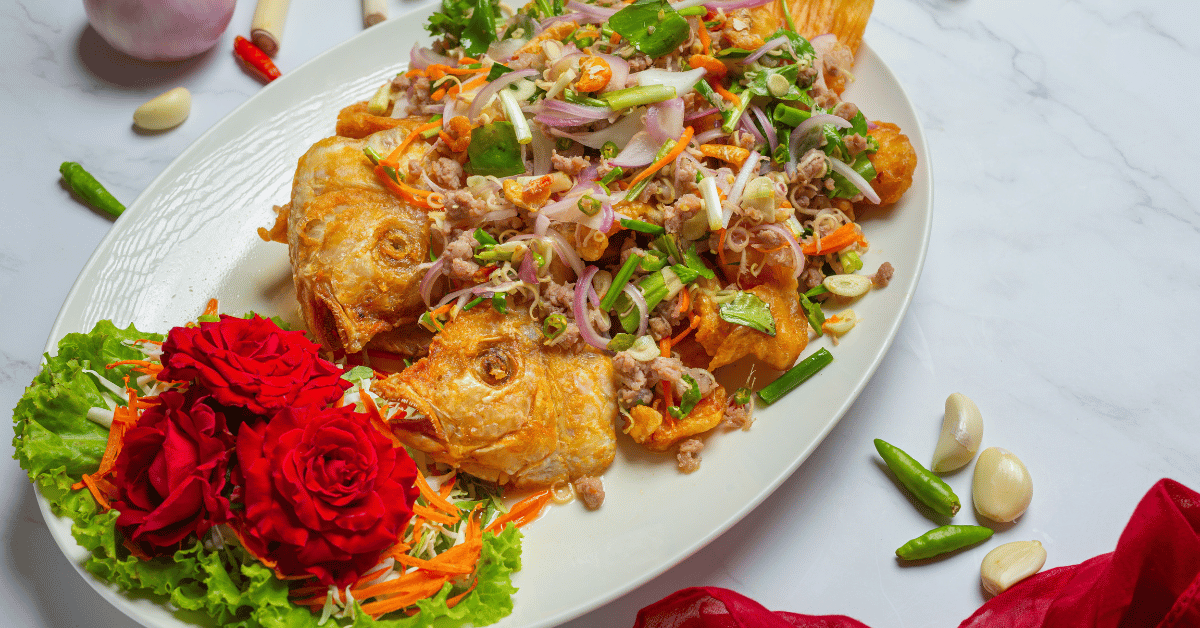In recent years, the term “Trat restaurant” has become more than just a reference to a place to eat; it now signals a movement within culinary circles that speaks to deep-rooted heritage, sustainable practices, and globally conscious dining. For someone looking to understand what defines a Trat restaurant, the simplest answer is this: it’s a dining space that honors the culinary identity of Trat—a small province in eastern Thailand—while elevating it with modern execution. Whether it’s nestled in the alleyways of Bangkok or found along the beachline in Koh Chang, the essence of a Trat restaurant remains consistent: bold seafood, subtle coconut notes, and the magic of fermentation paired with fresh ingredients. But more than food, it offers a cultural voyage on every plate.
As the culinary world becomes increasingly globalized, the focus on hyper-local cuisine has surged. This is where Trat cuisine, and by extension the Trat restaurant, shines. Chefs and restaurant owners are embracing the nuances of Trat’s unique produce, fishing heritage, and border culture. Unlike northern Thai or Isan fare, Trat cuisine is deeply influenced by its maritime borders and trade history with Cambodia, resulting in distinctly fragrant, sour, and spicy dishes. Diners are treated not only to dishes like salted crab curry or chili paste with sea almond leaves, but also to narratives that connect food to generations of fishermen, spice traders, and matriarchs preserving family recipes. Each Trat restaurant becomes a microcosm of culture and culinary storytelling, inviting visitors to taste the old and the new simultaneously.
While many assume Thai food is uniform, the diversity among regions is staggering, and Trat’s culinary offering has carved out its niche. To understand what sets a Trat restaurant apart from any standard Thai dining venue, one must explore its menu structure, the preparation styles, sourcing ethics, and even the architecture. “We cook with memory, not just with heat,” said one Trat restaurateur. This sentiment captures the emotional depth with which Trat cuisine is served—never simply for sustenance but to connect people across borders, time, and tradition.
Understanding Trat: The Culinary Soul of a Coastal Province
Trat is Thailand’s easternmost province, nestled on the Gulf of Thailand and bordering Cambodia. It is not just geographically significant, but culinarily rich, known for its variety of fresh seafood, locally harvested fruits, and ancestral fermentation methods. A Trat restaurant brings these elements forward in an accessible yet authentic way, which distinguishes it from more mainstream Thai eateries. The region’s culinary heritage is molded by its geography—coastal plains, islands like Koh Chang, and close proximity to cross-border markets. This has encouraged a fusion of Thai and Khmer flavors, contributing to Trat’s identity as a melting pot of textures and spices.
The classic menu at a Trat restaurant features deeply regional dishes that reflect seasonal availability and community knowledge. Ingredients like fingerroot, sea grapes, young durian, and preserved crabs are used generously. Unlike the sweetness associated with central Thai cuisine, Trat food leans heavily into sour and savory profiles, often using tamarind, fermented fish, and pickled fruits. “In Trat, the tongue must wake up,” a chef once quipped, pointing to the explosive flavor profiles that define the region’s cooking. In essence, a Trat restaurant is where cultural preservation meets innovative presentation.
Dining here is often an immersive experience. Many establishments use traditional architecture, bamboo seating, and earthenware to serve food. Others combine rustic charm with modern aesthetics, reflecting the dual nature of preserving heritage while appealing to global palates. But in both settings, what remains constant is the dedication to taste, seasonality, and storytelling. Meals are usually served in a communal fashion, encouraging diners to share, compare, and savor every bite—a practice that reflects the warm, inclusive culture of the province itself.
A Look Into the Signature Menu of a Trat Restaurant
The soul of any Trat restaurant lies in its menu, a carefully curated blend of familiar Thai staples and lesser-known regional treasures. While dishes like tom yum or green curry might occasionally appear, they are not the focal point. Instead, diners encounter plates like gaeng som pak krached (sour curry with water mimosa), yam kadook moo (crispy pork cartilage salad), and the celebrated gaeng kua prik kluea pu (salted crab curry with coconut milk and chili). These offerings are bold, briny, and strikingly aromatic.
In many Trat restaurants, seafood takes center stage, with everything from grilled squid to steamed horseshoe crab roe served with spicy dipping sauces. One of the more iconic components is “nam prik,” a class of chili pastes made with roasted ingredients, dried shrimp, and local herbs. These are paired with fresh vegetables, allowing diners to engage in a play of texture and heat. Fruits, too, are integrated in savory forms—green mango salads, stir-fried rambutans, or durian-based dips.
The menu often rotates with the fishing calendar. During the monsoon season, dishes become more reliant on pickled and fermented ingredients. In the dry season, fresh fish, scallops, and crabs dominate. The dynamic menu structure reflects a broader culinary philosophy: that food should be in harmony with nature’s rhythm. Whether served as tasting menus in high-end Trat restaurants or daily specials in beachside bistros, the dishes remain honest to their origins and captivating in flavor.
Table 1: Sample Menu Breakdown of a Traditional Trat Restaurant
| Course | Dish Name | Main Ingredients | Flavor Profile |
|---|---|---|---|
| Starter | Nam Prik Kapi | Shrimp paste, chili, lime, eggplant | Salty, spicy, umami |
| Salad | Yam Kadook Moo | Pork cartilage, herbs, lime, fish sauce | Sour, crunchy, fresh |
| Main Curry | Gaeng Kua Prik Kluea Pu | Crab, coconut milk, chili, salt | Rich, spicy, creamy |
| Grilled Dish | Pla Pao | Whole grilled fish, lemongrass, lime | Smoky, citrusy |
| Side | Pak Krached Tod | Water mimosa, garlic, oyster sauce | Earthy, umami |
| Dessert | Kluai Buat Chi | Bananas in coconut milk | Sweet, silky, fragrant |
Atmosphere and Interior: Where Ambience Reflects Culinary Identity
The ambiance of a Trat restaurant plays an essential role in delivering a complete dining experience. Unlike many modern establishments that prioritize sleek minimalism, Trat restaurants often opt for spaces that mirror the natural world and cultural memory. You may find walls adorned with old fishing nets, bamboo dividers, or wooden slats painted with murals of sea life and island folklore. The air is typically perfumed with lemongrass or grilled seafood wafting in from open kitchens, creating a sensory environment that complements the food.
Furniture choices are often inspired by rural Thai living—low tables, woven mats, and open-air seating areas designed to mimic coastal dining. Some restaurants even position their dining spaces directly along the water, giving diners the sounds of waves and the sight of fishermen hauling in their catch. This is not just ambience for aesthetic’s sake; it’s a reminder of the ecosystem that sustains the cuisine. Lighting tends to be soft and warm, casting a golden hue over dishes and inviting long, slow meals where conversation and flavor can fully unfold.
However, there are also more contemporary interpretations. Urban Trat restaurants often fuse local décor with industrial elements—polished cement walls, metal accents, and sleek wooden bars. Despite the modern presentation, the foundational ethos remains intact. “A Trat restaurant doesn’t forget where it comes from, even if it dresses up for the city,” said an architect who has worked on several such spaces in Bangkok. Whether rustic or refined, the ambience is always tethered to tradition and hospitality.
Behind the Kitchen Door: Ingredients, Sourcing, and Sustainability
What sets a Trat restaurant apart in today’s saturated food scene is its commitment to sustainable, local sourcing. Many restaurants work directly with fishermen, foragers, and farmers from within Trat province, ensuring a farm-to-table (or sea-to-table) experience. This not only supports local economies but also safeguards culinary integrity by reducing dependency on industrialized ingredients. The emphasis on freshness is paramount, with fish often reaching the grill mere hours after being caught.
Seasonality governs the kitchen. During certain months, crab fishing is restricted to allow population recovery, prompting chefs to substitute with preserved crab or other seafood options. Likewise, forest herbs used in signature spice pastes are harvested mindfully to ensure regrowth. Some Trat restaurants even cultivate their own herbs, lime trees, and galangal shrubs on-site or nearby. “We don’t just serve food, we grow part of it,” one restaurant owner explained. This hands-on relationship with nature fosters deeper culinary insight and flavor precision.
The kitchens themselves are often a mix of traditional fire stoves and modern equipment. Clay pots are used for slow stewing, while induction stoves ensure precision in high-volume operations. The blend of old and new is strategic—it preserves the soul of the cuisine while enhancing efficiency. Staff are frequently trained in traditional techniques such as fish smoking, coconut scraping, and chili paste pounding—skills rarely taught in contemporary culinary schools but vital in preserving authenticity.
Table 2: Seasonal Ingredient Usage in Trat Restaurants
| Ingredient | Season Available | Common Dishes | Notes on Sustainability |
|---|---|---|---|
| Blue Crab | March–June | Salted Crab Curry, Steamed Crab Rolls | Caught in small batches; seasonal limits |
| Sea Grapes | November–March | Spicy Sea Grape Salad | Hand-harvested, no netting required |
| Young Durian | April–August | Stir-fried with Shrimp Paste | Harvested early to reduce food waste |
| Tamarind Leaves | July–October | Tamarind Leaf Soup | Foraged in forested areas |
| Fingerroot | Year-round | Medicinal Curry Bases | Grown organically by family farms |
Culinary Tourism and the Rise of the Trat Restaurant Experience
With culinary tourism gaining momentum across Asia, Trat restaurants have become more than places to eat—they are now essential destinations for travelers seeking authenticity and immersion. This shift has inspired both local entrepreneurs and international chefs to invest in Trat as a culinary hub, opening new establishments that highlight traditional fare with innovative flair. In turn, these restaurants have elevated Trat’s visibility beyond its tranquil beaches and waterfalls, positioning it as a food destination.
For many tourists, discovering a Trat restaurant is a deeper way to understand Thai culture. Food tours often include visits to local markets, cooking classes, and evening meals in family-run Trat kitchens where diners learn the stories behind each dish. This storytelling element is a signature strength of Trat hospitality. “Food tells you where you are better than a guidebook,” said one Australian traveler after dining in Laem Ngop district. The appeal lies not only in taste, but in experience—sitting beside a dock as your fish is grilled, or hearing a grandmother explain how her pickled fruits are made without refrigeration.
Hotels and resorts in the region are also tapping into this movement. Many now offer in-house Trat-style dining or partner with local restaurants for authentic guest experiences. Some host seasonal food festivals or “catch-and-cook” excursions where tourists can fish, forage, and cook with local chefs. These activities not only stimulate tourism but empower local communities, ensuring that the culinary traditions of Trat are not lost to modernization or mass production.
Fusion Without Dilution: Trat Restaurants in Global Cities
As the Trat restaurant concept gains global traction, it is no longer confined to Thailand’s borders. Cities like New York, Tokyo, and London now house restaurants inspired by Trat’s culinary language. These establishments adapt to local ingredients but remain faithful to core flavors. For instance, instead of sea grapes, chefs might use sea asparagus; instead of Thai blue crabs, Atlantic ones are fermented using traditional Trat techniques. This adaptability has enabled Trat cuisine to resonate with global palates while maintaining its identity.
However, authenticity remains a priority. Chefs often travel to Trat for training or collaborate with Thai culinary consultants to ensure accuracy. Ingredients like fermented fish sauce, wild herbs, and sticky rice flour are imported to preserve taste integrity. “We adapt where we must but never compromise flavor,” said a head chef at a Trat-inspired restaurant in Melbourne. Such dedication is crucial in educating international diners about the nuances that make Trat food distinct from the broader category of Thai cuisine.
Moreover, these global Trat restaurants also serve as cultural ambassadors. Many host Thai festivals, art exhibitions, or language workshops alongside their dining offerings. Their role extends beyond gastronomy into cultural diplomacy, subtly reshaping how Thai culture is understood abroad. In doing so, they not only enrich the food scene in their host cities but also honor and amplify the traditions of a small Thai province with a rich, flavorful voice.
The Evolution of the Trat Chef: Artisans, Storytellers, Custodians
The people behind the meals in Trat restaurants are not merely cooks—they are artisans, historians, and often, community leaders. Many learned their craft not from culinary schools but from family kitchens, village elders, or by working at sea. The typical Trat chef understands the lifecycle of an ingredient: how it’s caught, when it’s ripe, what weather it grows best in, and how it reacts to fire or fermentation. This intimacy with ingredients transforms cooking into a form of storytelling.
In recent years, there’s been a growing movement of young Trat chefs returning home from Bangkok or abroad, determined to modernize local cuisine without losing its soul. They bring with them global techniques—plating finesse, fermentation science, and sustainable sourcing methods—and integrate these with their childhood flavors. This generation is not only preserving tradition but actively evolving it. “If I don’t cook my grandmother’s recipes, who will?” remarked one young chef who now runs a rooftop Trat restaurant in Chanthaburi.
Women play a particularly central role. In many Trat kitchens, it is the matriarch who dictates flavor, oversees fermentation cycles, and teaches the art of balance. Their knowledge is often undocumented, passed through intuition and repetition. Empowering these voices through restaurant entrepreneurship has created ripple effects—more female-led food businesses, better education for girls in culinary fields, and greater appreciation for domestic culinary labor. The Trat chef is no longer a silent figure in the back kitchen—they are at the forefront of cultural preservation and creative evolution.
Customer Experience: What It’s Like Dining at a Trat Restaurant
For diners, the experience of eating at a Trat restaurant is defined by more than just flavor—it’s the holistic orchestration of senses, memories, and service. From the moment a guest steps into the space, they are welcomed with a warmth that reflects Thai hospitality. Many restaurants greet guests with herbal drinks made from butterfly pea flowers or pandan, instantly setting a tone of relaxation and rootedness. The service is attentive yet unintrusive, encouraging a pace of dining that prioritizes enjoyment over efficiency.
Menus are often presented with explanations or stories behind dishes. Some restaurants even include QR codes linking to videos of how dishes are prepared or the fishermen who caught the ingredients. This narrative-driven experience transforms a meal into a cultural lesson. Children are often welcomed with smaller portions or playful presentations of traditional foods, while older guests are encouraged to sample the spicier, more complex items. It’s a form of intergenerational bridge-building through taste.
Additionally, many Trat restaurants now offer multi-sensory tasting menus that include scent diffusers, ambient music based on local folklore, or courses served in candle-lit outdoor gardens. These immersive elements are designed to slow down the dining process, inviting reflection. “Dining should be a memory, not a transaction,” said a Trat restaurant owner in Koh Mak. And it’s true—customers leave not just with full stomachs, but with vivid recollections of taste, texture, story, and place.
Challenges and Future Outlook for Trat Restaurants
Despite their growing appeal, Trat restaurants face several challenges. Sourcing fresh and sustainable ingredients consistently is becoming more difficult due to environmental degradation and overfishing. Climate change affects agricultural cycles and the availability of herbs like young tamarind or forest-grown galangal. Additionally, the rising cost of artisanal labor and the difficulty in training new chefs in traditional techniques pose threats to authenticity and continuity.
Another concern is the dilution of Trat cuisine under commercial pressure. As the demand for “authentic” Thai food grows in tourist hotspots, some restaurants may be tempted to simplify menus, tone down flavors, or cut corners on preparation time to increase profit margins. This risks alienating both local diners and international visitors who come seeking the true taste of Trat. Preserving culinary integrity requires vigilant effort and often comes at the cost of rapid scalability.
However, the future remains promising. With increased awareness of culinary heritage and sustainability, more diners are willing to pay for quality and story-rich dining experiences. Digital platforms also allow Trat restaurants to share their philosophy with a global audience, attracting food lovers from afar. Collaborations with travel agencies, culinary schools, and sustainable farming networks are growing, creating a robust ecosystem to support the next generation of Trat restaurateurs. As long as these restaurants stay true to their roots while embracing innovation, their relevance and influence will only continue to rise.
Conclusion: Why the Trat Restaurant Is More Than Just a Place to Eat
In today’s culinary world, where fast food chains dominate skylines and food delivery apps compress meals into mere transactions, the Trat restaurant stands as a beacon of cultural depth, flavor integrity, and sensory enrichment. It is not merely a venue to satisfy hunger, but a portal into a region’s history, environment, and community ethos. From salt-fermented crab curries to tamarind-leaf soups, every dish tells a story—a tale of sea winds, grandmother’s kitchens, and resilient foodways passed down through generations.
Trat restaurants invite us to pause and consider not only what we eat, but how and why we eat. They showcase the power of cuisine to connect past and present, local and global, rural and urban. “In every bite, there’s a memory,” said a respected elder chef in Trat. That memory is not static—it evolves with each new visitor, each young chef, each adaptive recipe. The future of Trat restaurants is not in replicating the past, but in honoring it while daring to dream forward.
As culinary tourism expands, and global palates grow more sophisticated, the Trat restaurant offers a timely reminder: food, at its best, is both anchor and sail. It roots us to where we come from and carries us to places we’ve never been. Whether you’re a local rediscovering forgotten tastes or a traveler seeking authentic stories, the Trat restaurant welcomes you—not just to dine, but to belong.
FAQs
1. What makes a Trat restaurant different from typical Thai restaurants?
Trat restaurants focus on regional flavors from eastern Thailand, emphasizing seafood, fermented ingredients, and seasonal herbs.
2. Are Trat restaurants suitable for vegetarians?
While seafood dominates the cuisine, many Trat restaurants offer plant-based dishes using local vegetables, herbs, and chili pastes.
3. Is the food at Trat restaurants very spicy?
Some dishes are spicy, but most restaurants adjust heat levels based on diner preference without compromising flavor depth.
4. Do Trat restaurants offer traditional desserts?
Yes, they often serve traditional Thai sweets like bananas in coconut milk or sticky rice with local fruits like durian or rambutan.
5. Can I find Trat restaurants outside Thailand?
Yes, several international cities now feature Trat-inspired restaurants that recreate authentic dishes using local and imported ingredients.











